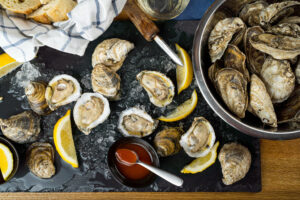New Fact Sheet Sheds Light on Preferences of Oyster Tourist
go.ncsu.edu/readext?962379
en Español / em Português
El inglés es el idioma de control de esta página. En la medida en que haya algún conflicto entre la traducción al inglés y la traducción, el inglés prevalece.
Al hacer clic en el enlace de traducción se activa un servicio de traducción gratuito para convertir la página al español. Al igual que con cualquier traducción por Internet, la conversión no es sensible al contexto y puede que no traduzca el texto en su significado original. NC State Extension no garantiza la exactitud del texto traducido. Por favor, tenga en cuenta que algunas aplicaciones y/o servicios pueden no funcionar como se espera cuando se traducen.
Português
Inglês é o idioma de controle desta página. Na medida que haja algum conflito entre o texto original em Inglês e a tradução, o Inglês prevalece.
Ao clicar no link de tradução, um serviço gratuito de tradução será ativado para converter a página para o Português. Como em qualquer tradução pela internet, a conversão não é sensivel ao contexto e pode não ocorrer a tradução para o significado orginal. O serviço de Extensão da Carolina do Norte (NC State Extension) não garante a exatidão do texto traduzido. Por favor, observe que algumas funções ou serviços podem não funcionar como esperado após a tradução.
English
English is the controlling language of this page. To the extent there is any conflict between the English text and the translation, English controls.
Clicking on the translation link activates a free translation service to convert the page to Spanish. As with any Internet translation, the conversion is not context-sensitive and may not translate the text to its original meaning. NC State Extension does not guarantee the accuracy of the translated text. Please note that some applications and/or services may not function as expected when translated.
Collapse ▲Written by Emily Prickett, Parks, Recreation and Tourism Major
When you think of North Carolina’s coast, what first comes to mind? Did you say oysters? Oysters have numerous health benefits with consumption along with various environmental impacts such as they can “filter up to 50 gallons of water each day (NC Coastal Federation n.d.), provide habitat for fish and other aquatic species, and support shoreline stabilization along the North Carolina coast” (Visitor Profiles… Oyster Tourism in North Carolina). While North Carolina’s coast is commonly known for its many wonderful beaches, it also draws in a number of consumers seeking various oyster experiences. Recent research conducted on potential oyster tourists revealed more about their travels. This allows the oyster industry to better accommodate their customers’ ideal oyster experiences.

Photo: Justin Kase Conder
A survey was conducted on potential tourists of the North Carolina coast. These participants came from in-state and the target markets of Ohio, Pennsylvania, and Virginia. Questions included interactions with oysters and their oyster preferences, among others. Statistical analysis of these data identified four main groups of oyster tourists. The four categories include oyster source seekers (33%), oyster enthusiasts (30%), oyster consumers (21%), and oyster opportunists (10%)*.
- Source seekers – Are more interested in the process of growth and harvesting.
- Enthusiasts – Are open to a variety of experiences such as tours, trails, events, dining, and education.
- Consumers – Are less frequently interacting with oysters and typically only participate in the dining experiences.
- Opportunitists – Infrequently seek out oysters and mainly participate in experiences that are convenient, such as dining at a restaurant.
This illustrates the most valued ideals of tourists visiting the coast and highlights their preferences specific to their interaction with oysters. Results highlighted that visitors are willing to pay a larger fee to experience attractions such as farm tours and will want to leave the experience with some of the product grown. Participants in the survey also expressed interest in oysters alongside outdoor recreation. This will appease the desire of travelers who want an active experience while exploring the area’s cuisine. Based on the survey results, 94% of tourists visiting North Carolina’s coast are interested in oyster experiences. Thus, the tourism industry should look for ways to address the different types of oyster tourists and provide experiences at different levels of involvement and interest.
While the oyster industry is already on the rise with the help of business owners and farmers, those in our coastal communities can capitalize on this increasing opportunity by taking the time to know the different types of oyster tourists and model their programs and experiences to satisfy specific needs. This new chance for growth brings the possibility of a positive impact on the environmental, social, and economic state of North Carolina’s coast.
Find the full fact sheet at this link: go.ncsu.edu/oystertourists. To learn more about the NC Oyster Trail visit their website and/or follow on Facebook (@NCOysterTrail) and Instagram (@ncoystertrail).
*The remaining 6% of the sample are oyster abstainers, those who do not consume oysters or are not interested.


